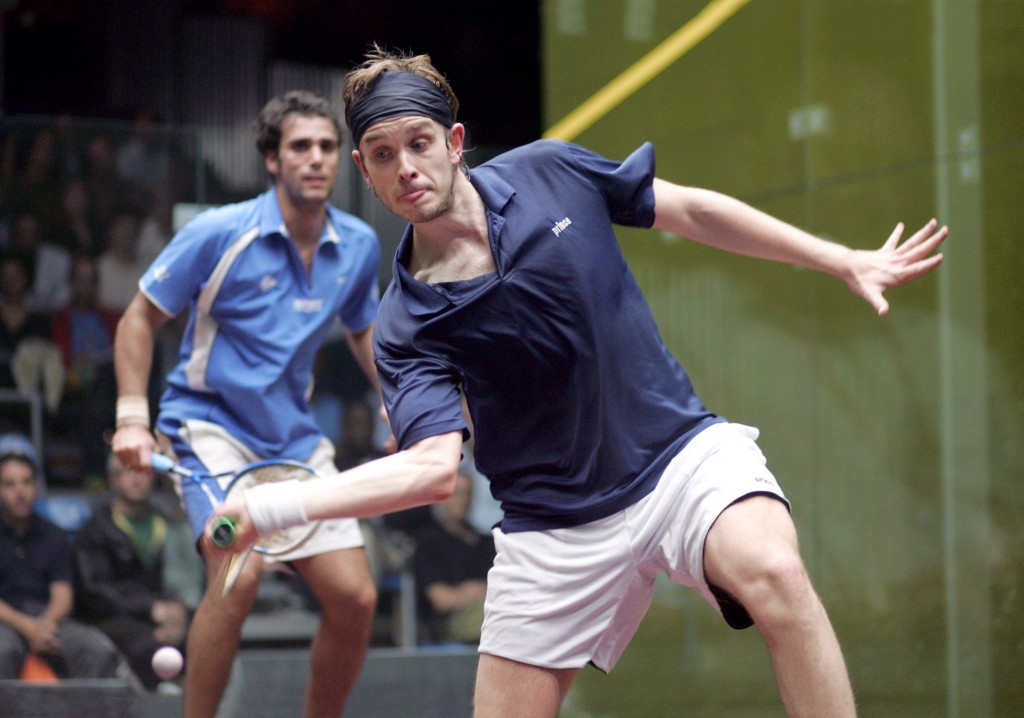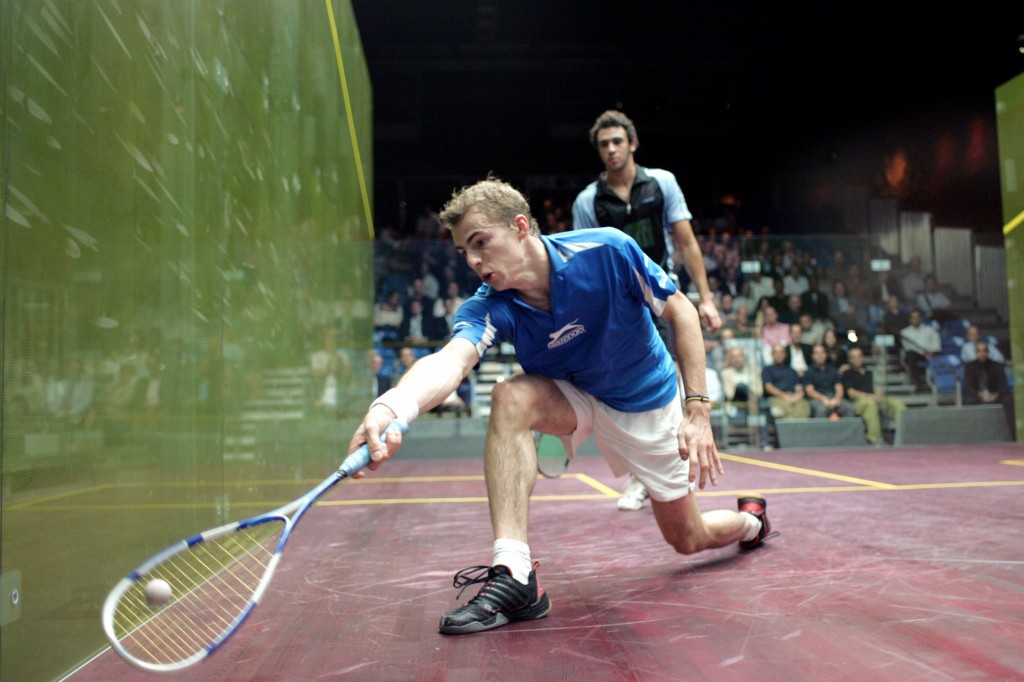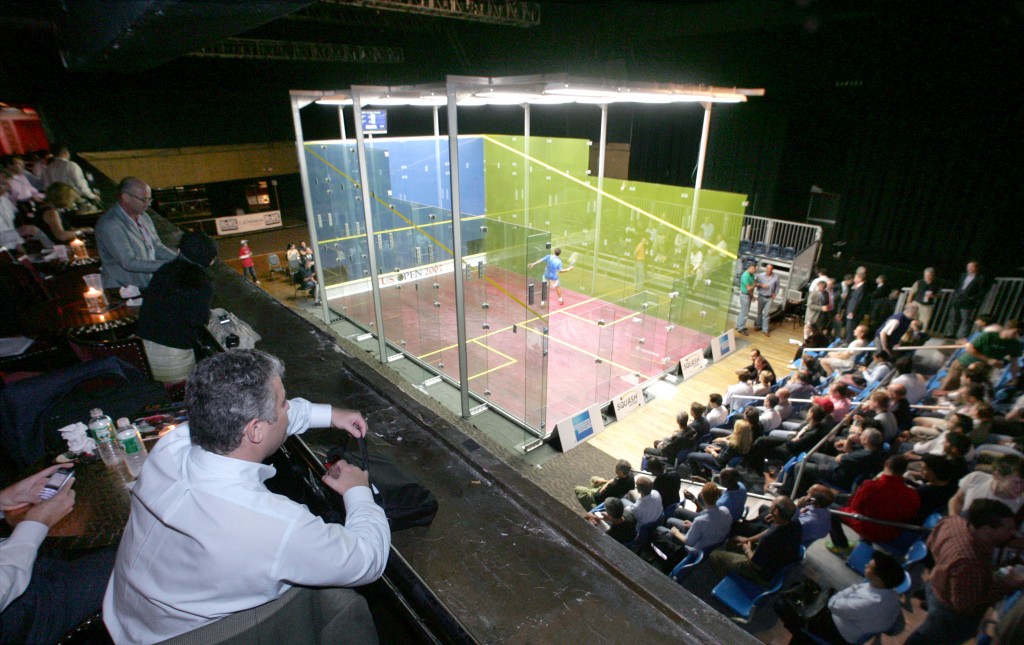
It was supposed to be an Egyptian confirmation, but instead the 2007 US Open became a British invasion. Forty-three years after the Beatles sent Americans into a tizzy on the Ed Sullivan Show, the US Open Squash Championships raised its curtain in its new home—the Roseland Ballroom.
Just a block from the B, D and E trains, the Ballroom sits at 52nd Street 100 yards off Broadway, and a short brisk walk from Times Square where it’s as bright at midnight as it is at noon. Talk about a dramatic contrast to the home of the Open over the past ten years where the Back Bay district of Boston had claimed it as its own. The Times Square locale was partly the result of US Squash having recently moved its digs to Manhattan and wanting to have its marquee professional event close to home, and partly to put the Open in an iconic space that could become an annual fixture on the PSA Tour.

Roseland Ballroom, as Jim Zug put it, is a “battered, funky hulk of a place,” that has potential for squash. Initially opening its doors in Philadelphia in 1918, the Roseland moved to New York in 1999 where it became a ballroom dancing mecca on 51st and Broadway. Throw in concerts, movie and Broadway openings, and the odd female prize fight here and there, and the Roseland Ballroom became synonymous with Midtown Manhattan. In 1956, the Ballroom moved to its current 52nd Street location where the Gay Blades Ice Skating Rink had been renovated.
Today, the Roseland Ballroom holds more than 50 concerts a year and a range of private parties and special events—including squash. With the court snugly tucked into the middle of the wide open space and seating along the sides and back wall (the place was begging for prime seating outside the front wall), the bright lights of the McWill glass box were a stark contrast to the black painted surroundings. But what better way to put squash under a spotlight? VIP seating along the balconies brought a touch of panache. While some accoutrements (like drapes to hide the seating structure and empty spaces outside the front wall), not to mention some Rock ‘N Roll to usher in the players, could add some polish, the surprising results from the tournament itself made for an intriguing week.
After completing the qualifying rounds and half of the first round at the Printing House in the West Village, the main draw moved uptown full of Egyptian expectations—not only among the ticket-buying fans, but also by the non-squash journalists who showed up every night plopping their behinds outside the front wall. That’s right, squash, for one week anyway, had the attention of mainstream publications like Men’s Vogue and the Wall Street Journal. When asked what their intentions were, both said quite simply, “we’re doing a feature on the players from Egypt.”
Two weeks earlier, the French contingent occupied both sides of the final at the British Open with Gregory Gaultier coming out with the title. And in the second round in NYC, six of the 16 players were Egyptian. And why wouldn’t they be? Five of them were ranked in the world’s top 20, led, of course, by No. 1 Amr Shabana and No. 2 Ramy Ashour. The surprising member of the final 16 was Omar Mossad, an unseeded qualifier who put out John White, the No. 7 seed, in the opening round.
But quietly flying under the radar were a trio of Brits, one of them a past US Open Champion in the form of Lee Beachill. James Willstrop, seeded No. 5, took 30 minutes to dispatch American wildcard, Gilly Lane, in three, and spent another 45 minutes wiping out the hopes of Malaysia’s Azlan Iskandar. Beechill eliminated the other Malaysian, Ong Beng Hee, in his opener, and then stopped the first of the Egyptians, Mossad, in three methodical games in the second round. And Nick Matthew, who must have felt like he was in Egypt instead of New York, quickly escaped the first round with three games over Hisham Ashour, Ramy’s older sibling, before a four-game effort in the second round to get past Mohammed Abbas, another Egyptian.
By quarterfinals night, everything seemed right with the squash world. The top players currently hail from Egypt (duhh), England and France—with apologies to the Aussies who were largely non-existent (except for Stewart Boswell who never got out of the Printing House)—and they occupied all eight of the quarterfinal spots.

Call it coincidence, but the Wall Street Journal, with its article rolling fast and furiously on the presses for their Wednesday morning delivery, may have wished it had at least acknowledged the talents of the Englishmen. Because all three shined bright and those witnessing the evening sensed a bit of “I’ll show you” energy. Willstrop, after dropping the first game to the British Open Champion, Gaultier, battled for 76 minutes to outlast the Frenchman in four. Matthew, who last climbed the podium at the 2006 British Open, was staring at possible defeat in his quarterfinal with the other Frenchman when Thierry Lincou took a commanding 2-1 lead. But, with near error-free stroke production, Matthew ran Lincou relentlessly for 90-plus minutes to put himself in the semis.
Though Beachill was up on Ramy Ashour, 2-1, the creative genius of Ashour carried him through, but not before Beachill had helped form a game plan for Matthew by extending the Egyptian phenom to five games.
The Journal article hit the newsstands on the morning of the semifinals, brazenly claiming that the Egyptians had “Cornered the Squash Racket.” If you ask the players, neither Willstrop or Matthew will claim to have felt an extra bit of motivation going into their matches with the article’s stars. The surprising half of the semis was that it wasn’t Shabana taking on Willstrop. Instead it was another Egyptian, Karim Darwish, who had advanced when Shabana was forced to retire with an injury in the quarters.

With the buzz about “the article” swirling around the room, Willstrop and Matthew each swatted that fly by playing nearly perfect squash. Willstrop, however, suffered mightily when Darwish extended him to five grueling games over 100 minutes. Matthew, on the other hand, took what he learned from watching Beachill the night before and turned it into a four-game slap in the face to Ashour. Rather than playing careful squash to keep Ashour at bay, Matthew attacked from the get go and frustrated the youthful Egyptian to the end.
As happens often, the final turned into a disappointment for those who came to watch two players kill each other. Willstrop simply had nothing in the tank after putting in such an exhausting effort in the quarters and semis. When asked afterwards if he felt any extra incentive after being overlooked during the week, Matthew put that notion to rest quickly. “The Egyptians have been dominating recently,” Matthew said. “So why not have an article? To be honest, I didn’t even think about the article. They’re one and two and who knows how many more in the top 20, and any article in a major newspaper on squash is a good article.” Hmmm.
Perhaps. But Matthew played with a renewed vigor that hasn’t been seen over the past 12 months. “I’m not that used to winning tournaments, you know,” said a laughing Matthew. But when asked what was different during this particular week, Matthew became introspective. “I think that sometimes you can almost want it too much,” Matthew explained. “You see the finish line rather than actually thinking about what you’re going to do and employ tactically on the match. Just let the win take care of itself. It’s something I’ve been working on at home, just not getting too far ahead of myself.”

And that may be exactly what carried him past Ramy Ashour. Matthew had dropped a tight first game, 9-11, and was facing another battle in the second after squandering a handful of game balls. But throughout the second game tiebreaker, Matthew always had the upper hand and eventually took it 16-14. From there you could sense that it was over. “I learned from watching Lee (Beachill) the night before,” recalled Matthew. “Even though he went two-nil down, he just took the game to Ramy. So I tried to combine that with doing all the basic things right.”
“We can work it” out may have been a hit from the Beatles back in the ‘60s, but these squash-playing boys from across the pond can still bring it on the squash court.





